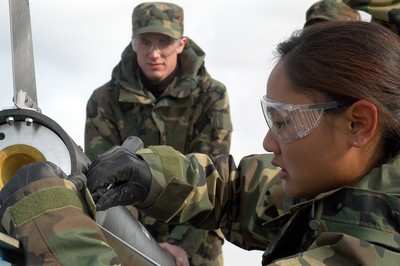Astronautics Offers AF Cadets Unique Opportunity
Not every college lets
students build and launch monster rockets and earn undergraduate
credit at the same time. Odds are they are more likely to be placed
on a list at the Homeland Security Department unless they are
attending the US Air Force Academy.
Astronautical Engineering 452/453 Rocket Engineering is the
academy’s two-course path to becoming a rocket scientist. A
group of engineering students moved a step closer to that goal when
a project took flight April 25 at nearby Fort Carson’s Pinon
Maneuver area.
"The second the rocket fired and took off, you could feel the
weight lifted from the shoulders of each and every cadet (who) had
put so much time and effort into something not many undergraduate
college kids can ever say they did. It was awesome!" said Cadet 1st
Class Chris Nations who was chosen randomly to press the "fire"
button.
Cadet Nation’s prompting sent an 11.5-foot tall, 7-inch
diameter, 115-pound rocket blasting away with 110 pounds of thrust
from a solid rocket motor. Maj. Dan Miller, program manager and
primary course instructor, said he feels the cadets’
experience is even more unique than they realize.
"No other university is building and launching this class of
rocket at the undergraduate level," the major said. "Cadets and
faculty went from blank paper to flight hardware in eight months.
This included developing the rocket motor with propellant,
insulation, throat and nozzle, pressure-vessel case [and] recovery
system."
Computer modeling predicted a flight of up to Mach 1.8.
"We probably didn’t get that, but from the sonic boom, we
[know we] broke the sound barrier," Major Miller said. The missile
fell short of its top speed and projected flight ceiling of 50,000
feet because of a parachute malfunction during flight.
The parachute inadvertently deployed early and at high speed,
Major Miller said. He said the problem will be fixed on future
projects.
Air Force Research Laboratory’s space propulsion division
officials took an interest in the cadet program in 2002 and began
funding it with $100,000 per year. The lab takes cadets on field
trips to government and industry sites of space propulsion interest
as well.
The big picture plan is to build a rocket large enough to reach
space, Major Miller said. Next year’s mission will shoot for
330,000 feet, and the Air Force Space Test Program officials plan
to put experimental payloads on future missions.
"The (academy) rocket program is going higher, faster and
farther than at any other time in its history," said Cadet 1st
Class Kevin Geoffroy, project’s chief engineer. "Our rocket
class will pass everything we have learned to ... the Class of
2005. They will benefit from the lessons we have learned as we did
from the Class of 2003."
Glad as he was to see the cadets’ rocket take to the air,
Major Miller said he is also pleased to have met an even more
important goal. One month from now, his rocket scientists leave the
academy and launch their own careers as Air Force officers and
leaders.

"Cadets [in the program] experience firsthand what the
‘real world’ is like," Major Miller said. "Technical
challenges, schedule delays, peers that can or cannot be counted on
… ; this is a yearlong leadership laboratory focused on a
specific goal. My objectives are not primarily rocket science, but
developing officers."
(ANN salutes USAF Tech. Sgt. James A. Rush, US Air Force
Academy Public Affairs)
 Aero-News: Quote of the Day (12.07.25)
Aero-News: Quote of the Day (12.07.25) ANN's Daily Aero-Linx (12.07.25)
ANN's Daily Aero-Linx (12.07.25) NTSB Final Report: Lafferty Jack Sea Rey
NTSB Final Report: Lafferty Jack Sea Rey Classic Aero-TV: The B29 SuperFortress Doc - History in Flight
Classic Aero-TV: The B29 SuperFortress Doc - History in Flight Airborne 12.08.25: Samaritans Purse Hijack, FAA Med Relief, China Rocket Fail
Airborne 12.08.25: Samaritans Purse Hijack, FAA Med Relief, China Rocket Fail



